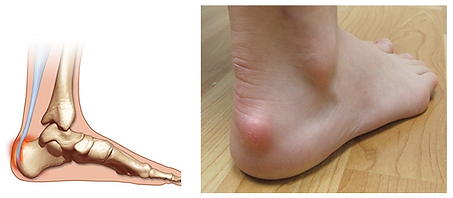BURSITIS
What is Bursitis?
Bursitis is the inflammation and swelling of a bursa.
A bursa is a small fluid-filled cushioning sac located near tendons, ligaments, skin, and muscles. The bursa works by protecting structures that would otherwise rub directly across the surface of a bone and cause damage or irritation.
It can occur across the body in the hip, elbow, knees as well as feet. In the feet bursitis is commonly found at the back of the heel, under the heel, under the ball of the foot and at the side of a bunion.
What causes it?
Bursitis will often develop due to injury, repetitive movement or friction.
The cause of bursitis in the foot is predominantly due to irritation from repetitive use and overuse, such as during prolonged standing or running. Direct pressure applied to an area over a bursa, such as from wearing shoes that are too tight, may also be a causative factor.
Certain foot and gait abnormalities such as flat feet, bunions or hammer toes can place additional stress on the bursa and lead to bursitis.
Less commonly, bursitis can develop as a result of an infection or as a complication of certain other pre-existing conditions, such as gout or rheumatoid arthritis.
What are the symptoms?
The joint may be:
• painful – usually a dull, achy pain
• tender or warm
• swollen or red
• more painful when you move it or press on it
What will happen if I leave it?
The pain can often improve within a few weeks, but the swelling may take longer to completely disappear. Exactly how long it takes to recover may depend on where the bursitis is and whether it was caused by an infection.
If it is an infection it could be septic bursitis. This can lead to additional symptoms such as a high temperature or fever, flu-like shivers, an infection of the deeper layers of the skin or an accumulation of broken skin over the affected area.
What can help?
To prevent bursitis developing there are several small things that can have a big impact. If you run or walk regularly, make sure your walking or running shoes fit properly.
If you continue having problems with your shoes, a podiatrist will be able to provide a more expert opinion and look at your overall lower limb biomechanics.
Losing weight will help reduce the load on your feet.
What are the treatment options?
Firstly you should try a few things yourself at home
• Wear shoes which are nice and broad at the forefoot
• Don’t lace the forefoot part of your shoe too tight
• Make sure your feet are in supportive shoes that do not squeeze your forefoot
• If possible, try to avoid shoes which taper towards a point
You can use the following 3 steps to help bring down swelling and pain:
• Rest – try not to move the joint too much, and avoid activities that'll put pressure on it.
• Ice – gently hold an ice pack (or a bag of frozen peas) wrapped in a tea towel on the area for around 10 minutes at a time and repeat every few hours during the day.
• Elevate – keep the area raised to the level of your heart as much as possible.
Take painkillers, such as paracetamol or ibuprofen, to ease any pain.
If the above advice isn’t helping you manage the pain, the next step is to come and get it looked at by your podiatrist.
Their treatment may include
• Additional footwear advice
• Deflective padding in your shoes
• Orthotics
However, if the swelling caused by bursitis is particularly severe, you may want to consider having the fluid drained out. This procedure is known as aspiration, and it can relieve the pain and improve the range of movement in your joint. During aspiration, a needle is used to draw out the fluid from the bursa.
This will be sent off to test for infections, and may also help your symptoms.
Aspiration might be done in your GP surgery or you may be referred to the hospital.
If your symptoms prove persistent and resistant to treatment a specialist can inject corticosteroids directly into the affected area.
In severe cases, surgery may be recommended to remove the affected bursa, particularly where septic bursitis does not respond to antibiotics. Surgery either involves removing the bursa completely, or making an incision in your skin and draining the fluid out of the bursa.



